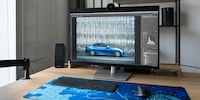

FlipGo Dual test: a portable monitor for digital nomads
The dual display from FreeVoice, priced at 649 francs, increases your work surface with two 16-inch screens. In my test, it proved a good solution for flexible work locations. However, there are a few technical weaknesses.
With the rise of digital nomads, portable monitors are becoming increasingly popular. Fellow editor Jan Johannsen recently highlighted their fundamental advantages and disadvantages here. Simple models are available from as little as 150 francs. If you want more surface area and better image quality, you’ll have to dig deeper into your pockets. For example, I’m testing the FreeVoice FlipGo Dual, which costs 649 francs.

Source: Samuel Buchmann
For this higher price, you get a fold-out double display. The two 16-inch screens are arranged one above the other, and in Windows, you can also rotate them 90 degrees to operate them side by side. They draw power either from a power supply unit or via USB-C from a laptop. Here are the specs:
- Format: 2 × 16 inches, 16:10, matt coating
- Resolution: 2,560 × 1,600 pixels each, 189 ppi pixel density
- Brightness: maximum 500 nits
- Frame rate: 60 hertz
- Colour space coverage: 100 per cent sRGB
- Connections: mini HDMI, USB-C
- Weight: 1.59 kilogrammes
The manufacturer doesn’t provide any information on response time. Since nobody wants to game on a portable display, this hardly matters.
Restricted mobile operation
The FlipGo Dual’s supplied with a hinged stand. It’s small, but surprisingly stable. I place the display next to my 16-inch MacBook Pro and connect it via USB-C. Since the port is on the left, I place it to the left of my laptop and feed the cable through behind the external display. In the opposite arrangement, I’d have to move it slightly backwards so the plug isn’t in the way.

Source: Samuel Buchmann
The portable monitor also works via USB-C without an additional power supply. This way it’ll drain the laptop battery, of course. With my MacBook Pro, I can work for around five hours. It lasts more than twice as long without an external monitor.

Source: Samuel Buchmann
Power option number two: I plug the power supply unit into the second USB-C port. Maximum brightness increases and the portable monitor becomes a docking station, charging my MacBook. However, the 65-watt power supply unit’s too weak for two devices. If I increase the brightness of the display and charge the laptop at the same time, the FlipGo Dual becomes unstable and constantly restarts – this can result in an endless loop since I can’t get into the menu quickly enough to lower the brightness again before the next restart.
A more powerful power supply, like the one on my MacBook Pro with 140 watts, solves the problem. Otherwise, the full brightness of 500 nits can only be used when the laptop battery’s charged or if I connect the monitor via HDMI. Such a design flaw has no place in a premium product. As a minimum, energy management should lock the brightness before the power supply unit panics and pulls the emergency brake.
Colour accurate, nice and bright when connected
With a resolution of 2,560 × 1,600 pixels each, both displays have a relatively high pixel density of 189 pixels per inch (ppi). Most other portable monitors have to make do with Full HD resolution – although this is also sufficient. There’s a big difference in brightness between use with or without a power supply unit. The display only achieves 78 nits when connected to a laptop. At best, this’ll be fine in a dark room. With the power supply unit, it’s up to 493 nits, a decent value. The monitor doesn’t support HDR.
Greyscales are well under control, the gamma curve shows no major outliers. Brightness gradations are displayed fairly accurately as a result. The white balance is too cool by default, which, fortunately, can be remedied with manual RGB settings. The maximum contrast is 1,200:1 – a typical value for an IPS display.

Source: Samuel Buchmann
Colour accuracy’s fine too. The display’s tuned to the DCI-P3 colour space, which it covers by 99 per cent. There, the average DeltaE of the colour deviation is 3.3, a solid value. The AdobeRGB coverage is also impressive (96.2 per cent). After calibration, the FlipGo Dual would certainly be suitable for professional graphics work.

Source: Samuel Buchmann
Works better with Windows
I normally arrange several screens next to each other. The concept of two on top of each other is unusual, but I’m surprised at how much I like it. I move less important windows to the top half. This means they aren’t directly in the focus of my field of vision, but can still be seen without changing windows if necessary. The FlipGo Dual triples the work surface of my MacBook.
However, there’s a catch: I can only use the display in portrait mode under macOS, and only in Ultra mode. In this case, the system recognises it as a single large monitor. If I maximise a window, it enlarges over both parts. Not great, as my view’s interrupted in the middle by bezels, so I have to adjust the windows manually.

Source: Samuel Buchmann
The second disadvantage in macOS concerns scaling. The display’s only sharp in native levels – i.e. either 2,560 × 3,200 or «like 1,280 × 1,600». The original resolution results in a tiny display. Double the size, on the other hand, is very large when I place the FlipGo Dual at laptop distance.
These problems don’t exist in Windows. Here, I can scale the system interface in 25 per cent increments and the image always looks sharp. Using DisplayLink software, the FlipGo Dual can also be divided into two virtual screens or rotated by 90 degrees.
In a nutshell
Good for remote workstations
The FlipGo Dual’s an interesting solution for digital nomads. In a holiday flat or co-working space, you can quickly set up a workstation with more screen space. With a power connection, the portable monitor even functions as a docking station for laptops.
Its 1.59 kilogrammes would be too much for me to lug the display around in my backpack. And in mobile mode, it drains the laptop battery too quick and just isn’t bright enough. As a result, the FlipGo Dual isn’t suitable for work in between meals in a café. It works better in a suitcase.
Is the premium price justified? Yes and no. The picture quality’s good. When connected to a power supply, the FlipGo Dual’s nice and bright, the colour display accurate and the sharpness good. However, the included power supply unit’s too weak. If you charge your laptop via the portable monitor during operation, don’t make it too bright. Otherwise it’ll constantly restart since there isn’t enough power. This shouldn’t happen in this price range.
The device works better with Windows than macOS. With the latter, you’ll have to tolerate the standard scaling and you can't let the fact that the two separate displays act as one large screen bother you. If you want as big a portable work area as possible in a compact package, I can still recommend the FlipGo Dual with these limitations.
Pro
- Lots of extra work surface
- Solid design
- Good image quality
- Nice and bright when connected to power
- Relatively compact and lightweight
Contra
- Power supply unit too weak
- Buggy energy management
- Too dark when unplugged
- Slightly limited with macOS
- Rather expensive

My fingerprint often changes so drastically that my MacBook doesn't recognise it anymore. The reason? If I'm not clinging to a monitor or camera, I'm probably clinging to a rockface by the tips of my fingers.



